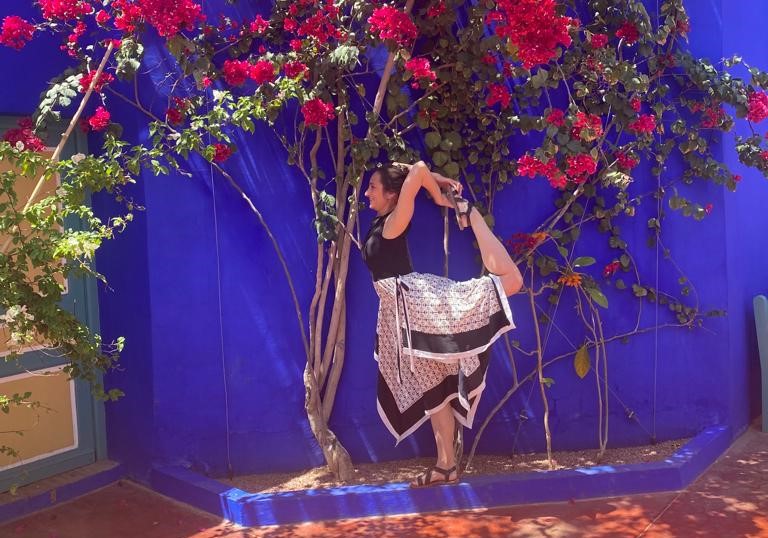It’s International Day of Yoga today, a celebration which India’s Prime Minister Narendra Modi helped bring to life almost ten years ago. International Yoga Day is celebrated on the 21st of June, as it is the longest day of the year in the Northern Hemisphere, while in Hindu calendars the second full moon after summer solstice is known as Guru Poornima, a day of respect for all gurus (or teachers) and the day when the first yogi – Lord Shiva – is said to have begun spreading the knowledge of yoga to the rest of humankind, making him the first yoga guru. His first student was Goddess Parvati, his companion who became a guru too, known as uday nath.
One paragraph in and we’re already deep in the history of yoga! But what better day than this to talk about yoga and what it means for us?
Yoga, Asan, the Mind & Unity
As most of you will know, Mira and I were taught yoga by our Indian father when we were four and six years old. The famous sage Patanjali’s words “Yogas chitt vritt nirodha” were instilled in our minds and plastered in Devanagri (the scripture of Sanskrit and also Hindi) all over the walls of our childhood home – योगस चित्त वृत्ति निरोध I
We started learning asan (postures), pranayam (breathing), kriya (creating, moving, cleansing), Sanskrit (and the Yogic scriptures), and most of all we learnt what योगस चित्त वृत्ति निरोध actually meant: “Yoga is the stilling of mental fluctuations.” And if this sounds like meditation, you are right, it is. But for many, it starts with the body:
Asan (no “a” at the end) is stillness of the body, in order to achieve stillness of the mind – the stilling of these mental fluctuations is easier when the body is ready. So in asan practice, we use the body to move beyond the physical experience, acknowledging all transient things and coming into unity with everything in and around us.
The Hatha Yoga Path
This unity does not happen overnight, and it might be years until you feel that asan practice helps you on your path. Now, we call asan most types of physical activity in yoga – whether the way you’re practising it is faster and flowing (think Vinyasa or Rocket) or whether it’s slow (as in yin or restorative) or slow and strong, which to us is the essence of asan practice: a long holding of a posture to learn about your body in this particular moment, feeling and anticipating tightness or even pain, waiting for a “pranic response” (listening to how the breath responds to the pose, which will have an effect on the rest of the body) and letting the breath go back to its baseline.
Hatha Yoga (which is actually pronounced hatt yog) is often called a style of yoga, and when we first started teaching, we were invariably asked what style of yoga we taught. We never knew how to answer this. To us, yoga was yoga, not a style. We’ve since found out that when people ask it, they want to know how you practise your asan. Hath means forceful, strict and disciplined – and rather than being a style of yoga, we should call it a path (or marg). And just as there are many different religions, psychological concepts, philosophical currents and sciences out there, so there are many different yogic paths, all of which have the same aim: liberation.
The Hath path – and this is the marg that Mira and I learned – comes from the Nath lineage (like Parvati, Maha Yogi Matsyendra Nath received this knowledge from Shiva himself). It is associated with the subtle body and energy – pran (or chi), nadis, kundalini – and when we practise this, we try to liberate ourselves through changing the body’s physiology, psychology and chemistry as well as the architecture of the brain in order to release the old structures of being and thinking: losing our ego, our self, our judgments, our unconscious biases. Ultimately, transcending all of this means liberating and “uniting” (one translation of the word “yoga”). This unity could start with alignment in a posture, with achieving an equilibrium of the left and right nostrils, the unity of the left and right brain hemispheres. But ultimately it’s about seeing that our body is nature, that we are connected to who and what is around us. We are not an individual thing and our identity is a construct, a narrative in our head, which yoga helps us see and move beyond.
As that is what yoga is for us, it won’t be a surprise that we don’t believe in yoga awards or shoutouts for “best yoga clothing brand” or even “best teacher”. We are all the same, all here together on this planet, and we are here to be happy.
And if you want to spread a little bit of that happiness in your office, then the Pathak Yoga family is here for you 🥰

